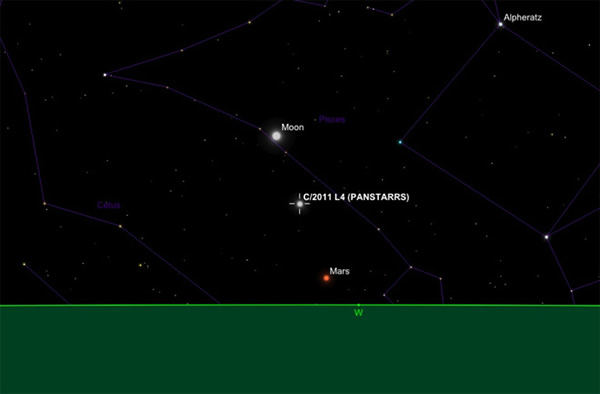'Hairy' Visitor: How to Observe Comet Panstarrs
The location of Comet Panstarrs in the night sky for the Nothern Hemisphere on March 12, 2013.
Like our ancestors, I'm usually filled with dread at the appearance of a new comet; for them it was because they were considered harbingers of doom but for me it's because people look to me (an astronomer) to forecast how bright (or not) they may become.
Therein lies the problem -- comets are notoriously difficult to predict. You only have to look at Comet Kohoutek in 1973, dubbed by many as the "Comet of the Century," which turned out to be a flop. I find myself here again, with Comet C/2011 L4 (PANSTARRS) on the verge of making its Northern Hemisphere debut and people are asking me how it is likely to perform.
One of the reasons the brightness of a comet is hard to predict is that we can never be sure about how much "outgassing" is going to occur. Outgassing is the process where gas, which was previously trapped or frozen in the comet's nucleus, is released into space and, given that the nucleus of a comet is predominantly made of ice, it's not surprising that outgassing can be quite extreme as it nears the sun, heating up.
In fact, it's this process that produces the vast coma surrounding the small icy nucleus. The force from the solar wind pushing against this gas will produce a comet's trademark tail.
Interestingly, the tail of a comet is responsible for their name that comes from the Greek word 'kometes' meaning long-haired star.
Comet Panstarrs, as it is generally known, was discovered back in June 2011 by the Panoramic Survey Telescope & Rapid Response System (Pan-STARRS) based at the University of Hawaii's Institute for Astronomy.
Since its discovery, it has been slowly heading toward the inner solar system reaching its closest point to the sun, known as perihelion, on March 10. Since its discovery we've had great hopes for this one becoming a bright "naked eye" comet with early estimates as bright as magnitude -4 which puts it on a parr with Venus. Further observations revealed that its brightness increase was slowing down suggesting less outgassing activity than predicted.
It now looks like its maximum brightness will reach only magnitude 3, a far cry from the brightness of Venus but still visible to the naked eye.
Mar 7, 2013 07:00 AM E by Mark Thompson












